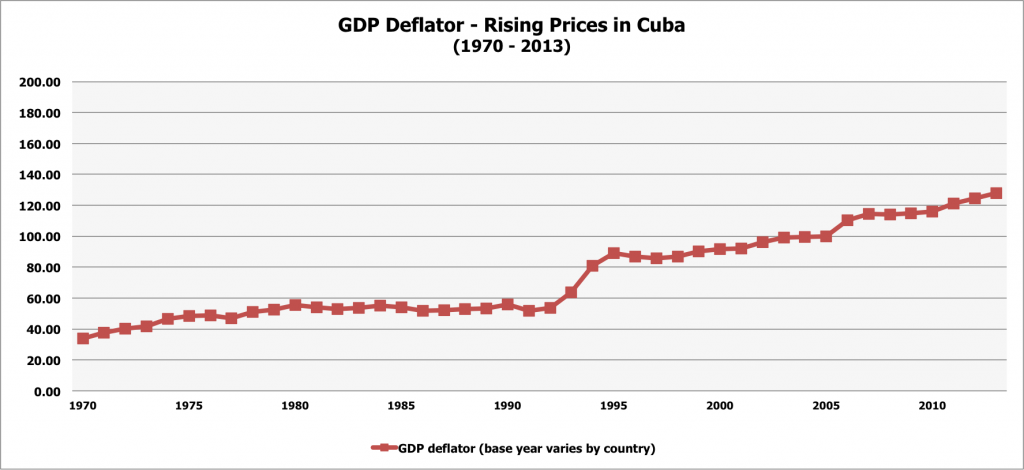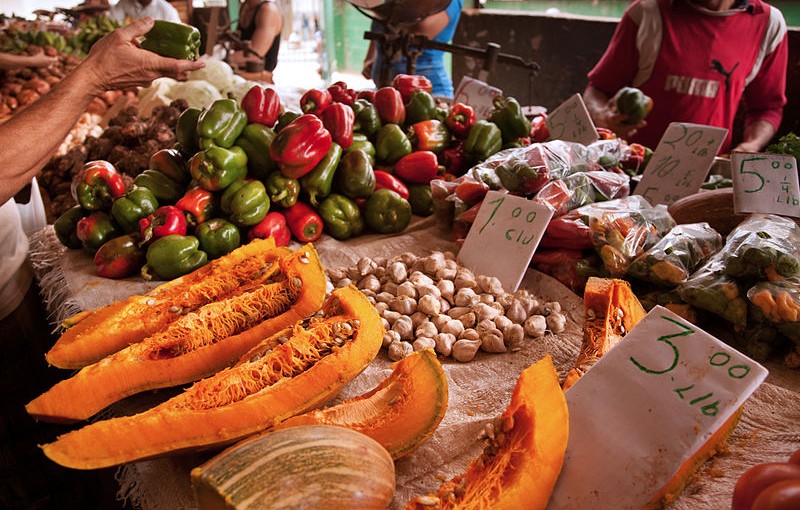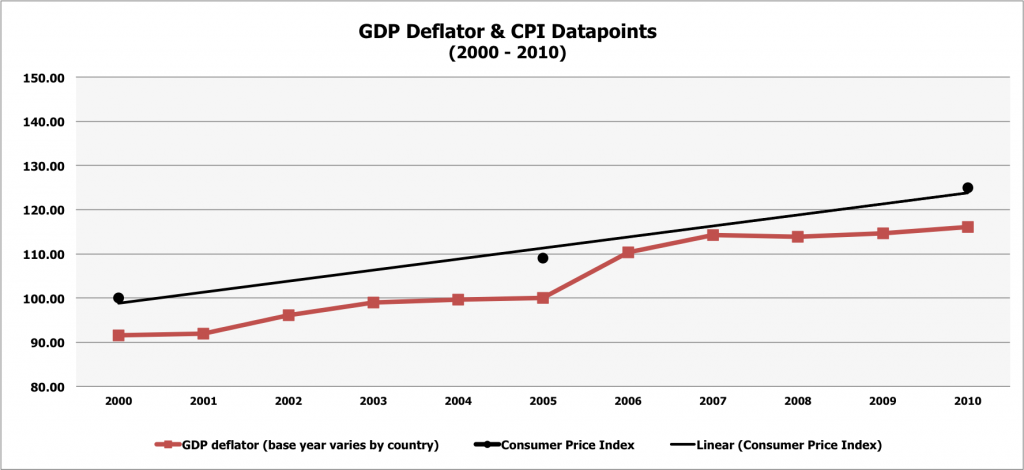Fast Facts:
Consumer Prices:
– Since 1990, consumer prices increased by almost 130%.
– Government monitors and regulates consumer prices.
– Ministry of Finance and Prices is expected to cut prices for certain basic food and household items by 10-30%.
Inflation & Hyperinflation:
– Limited information is available about inflation rates in Cuba.
– Current inflation rate for consumer prices is 4.4% (2015 estimate).
– GDP deflator and CPI steadily increased throughout 2000s.
– No evidence of Cuba having experienced periods of severe inflation that would be categorized as hyperinflation.
Overview of Consumer Prices:
Over the last 40 years, consumer prices have been increasing. Prices incrementally increased each year from 1970 to 1990. Since 1990, there has been a large increase in prices all the way through 2013. This makes sense, as over those years, we have observed an increase in real GDP and wages, which are correlated to price increases.
The Cuban Ministry of Finance and Prices will be addressing the issue of increasing consumer prices by lowering prices for basic household items (e.g. detergent, cooking oil, meat, etc.) by 10-30% in the majority of government-run stores. It is speculated that these pending price cuts are being implemented because many Cuban consumers have not yet benefited from the economic reforms that Raul Castro began implementing in 2011. We believe that this speculation is correct, because based on our own analysis, the Cuban government has been making efforts to combat its decades-long emigration issue by increasing the quality of life for its population (e.g., permitting certain types of entrepreneurship and small business ownership, increasing wages for workers in several sectors, etc.). Making consumer staples more affordable to the average Cuban resident is a clear continuation of such efforts.
As potential investors, we view the government’s efforts to monitor and lower prices for food and basic household items as a positive economic indicator, because this means that Cuban consumers will have more income to spend on other types of goods and services. For example, by spending 10-30% less on many basic grocery store items, a consumer could proceed to spend that 10-30% savings on services (such as restaurant meals or the internet) or to purchase goods/products (such clothing or music/movies).
GDP Deflator & Consumer Price Index (CPI):
By looking at the GDP deflator we can see how much goods and services have historically cost in Cuba and how they compare to prices today. The GDP deflator has increased from a low of about 34 in 1970 to 128 in 2013 (the most recently published figure). The GDP deflator includes changes in prices of all items produced in Cuba and excludes all imports. The base year for the GDP deflator is 2005. This means that in 2013, prices of goods and services were 28% more expensive than in 2005.
 Meanwhile, the Consumer Price Index (CPI) tracks changes in the prices of all items bought by Cuban residents, regardless of where the items are made. Although Cuba has not readily published it’s CPI data, the United Nations has published limited CPI data for Cuba. The UN’s data begins with a CPI base year of 2000 and contains data points for years 2005 and 2010, with the CPI index being 109 and 125, respectively. Based on the UN available data, we can tell that prices increased by 25% from 2000 to 2010.
Meanwhile, the Consumer Price Index (CPI) tracks changes in the prices of all items bought by Cuban residents, regardless of where the items are made. Although Cuba has not readily published it’s CPI data, the United Nations has published limited CPI data for Cuba. The UN’s data begins with a CPI base year of 2000 and contains data points for years 2005 and 2010, with the CPI index being 109 and 125, respectively. Based on the UN available data, we can tell that prices increased by 25% from 2000 to 2010.
The GDP deflator closely mirrors the CPI, particularly in Cuba, because it has very few imports. Furthermore, the majority of the imports that it does have, such as petroleum and machinery/equipment, do not have a direct impact on a typical consumer. As shown by the graph below, one can tell that the CPI and GDP deflator follow similar trends.
Inflation Rates for Consumer Prices:
– 2015: 4.4%
– 2014: 5.3%
– World Ranking: 165
Cuba does not appear to openly release information about inflation within the country. However, we can infer from the GDP deflator, real GDP growth, and the CPI that inflation does in fact exist in Cuba. Growing prices on goods, as well as increasing wages indicate that there is a certain amount of inflation. The CIA Factbook has very limited information about inflation rates in Cuba, and only shows that the inflation rate for consumer prices was 5.3% in 2014 and 4.4% in 2015. These two figures appear to be relatively normal, given the increases in real GDP and GDP deflator/CPI, particularly for a country that is completely controlled and run by the government.
Hyperinflation:
As discussed above, there is limited information available with respect to inflation rates in Cuba. We see the overall trend of the GDP deflator, increasing consumer prices and wages, and the 2014 and 2015 inflation figures to represent normal inflation levels that are controlled by the Cuban government. Throughout our research and analysis, we have not seen any evidence that would indicate that Cuba has experienced periods of severe inflation that would be categorized as “hyperinflation.” We also believe that any instances of hyperinflation would have been highly publicized events and would have caused a large and very noticeable spike in Cuba’s net migration figures.
Sources:
The CIA World Factbook
The World Bank – World Development Indicators
Reuters Article – “Cuba to cut prices on some consumer goods at hard currency stores: workers”
UNdata – United Nations Statistics Division

